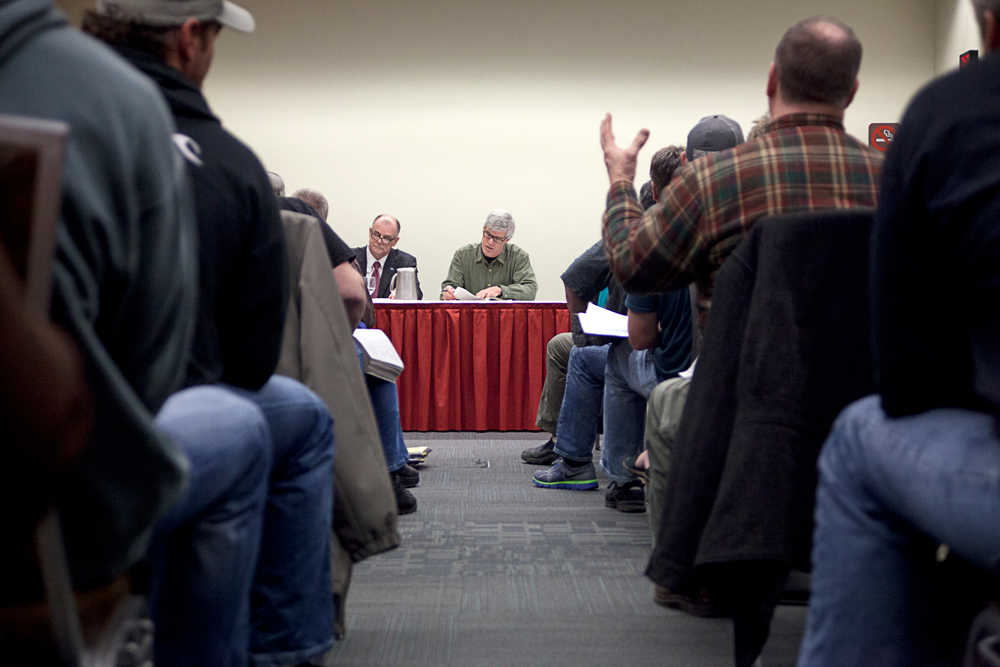Update: The Board of Fisheries convened Sunday at 8 a.m. and voted to approve a board generated proposal to restrict stacked setnet permit operations.
The regulations affect just the setnet permit operations in the Upper Subdistrict of the Cook Inlet; commercial setnet fishers in the Northern District and on the west side of the Cook Inlet are unaffected and may still fish a full complement of gear, according to board testimony.
—
ANCHORAGE — The Alaska Board of Fisheries on Saturday took up a proposal to eliminate permit stacking in Cook Inlet commercial fisheries. While the board ultimately voted the measure down, a board generated proposal that would limit the amount of gear a two-permit holder could have in the water is set to be taken up today.
The board generated proposal would require a commercial setnet fisher — who can operate an aggregate length of set gillnets of 210 feet in length — to operate no more than 105 feet of gillnet at the 29 meshes deep, a reduction of 16 meshes in depth.
During the last board cycle in 2011, the board allowed a single person to operate two legal sets of set gillnet gear in the Upper Cook Inlet if that person owned two permits; prior to 2011 a person could own two but could only fish one of them.
According to Commercial Fisheries Entry Commmission, or CFEC, data from 2012, there are 736 salmon set gillnet permits in Cook Inlet. Of those, just over 83 percent belong to Alaskans.
“Family is significant here,” said Tom Kluberton, board member from Talkeetna. “I heard many four generations and three generations in this inlet. I’d say the predominant on this beach are family fishing site generations.”
Kluberton said he was unwilling to support the elimination of permit stacking, in part because of fresh time and gear restrictions on the fishery passed by the board earlier this week.
“We’re going to put these people through one more hoop while they’re already having enough trouble dealing with low king salmon abundance, tumbling permit prices, high costs of living, beached completely in 2012 and now in addition to everything else they’re going to start juggling permits,” Kluberton said.
While attendance to deliberations and committee meetings has steadily declined since the first days of testimony, at least fifty people moved into the room during the permit stacking discussion.
The Kenai River Sportfishing Association, a prominent sportfishing advocacy group, submitted the original proposal. The proposal originally called for the elimination of permit stacking in both the commercial drift and set gillnet fisheries, however, board members approved an amendment to leave the drift fishery untouched, focusing instead on the set gillnet fishery.
According to the KRSA proposal, allowing permit stacking could introduce more setnet gear in the inlet by bringing long-time latent permits back into use in the fishery.
According to CFEC data on the number of latent permits, 575 permits of the 736 in the fishery were used to record a landing in 2012 and the agency estimates a latency rate of about 22 percent.
During his testimony, Kluberton said he did not believe latent permits were going to be an issue in the Cook Inlet.
“Some folks say we’re going to have a bunch of latent permits come out in the fishery and kill more king salmon,” he said. “I don’t see it.”
In 2011, stacked setnet operations had an average ex-vessel value of $71,320, whereas single setnet permit operations drew in about $38,000 according to CFEC data — 93 percent of the setnet operations in the Cook Inlet are single permit operations, while 7 percent are stacked.
Sue Jeffrey, board member from Kodiak and a CFEC permit holder, said she did not support stacked permit systems as it consolidated operations and made entry into a fishery more difficult.
“I don’t think that this is the best thing for state policy, for Alaskans to have permits really tied up,” she said. “There’s not much opportunity for young people … I think that permit stacking closes a door.”
After multiple amendments were made to the proposal — including one that would have introduced a sunset clause, allowing setnetters to fish the upcoming fishing season under the current configuration — eventually the board had to stand down to clarify what it would be doing with the proposed regulation.
Kluberton said the board had just allowed permit stacking in the inlet three years before and should consider the impact on business when changing it again.
“I think it’s just wrong for this board to tumble these business plans over every three years,” he said. “We walk in, we put a regulation in place, come back three years later and tip it upside down… I just find that I can’t buy into that. I can’t put an individual, a family, any group through that much instability in their business for some benefit that’s perceived by some.”
The board will reconvene at 8 a.m. at the Egan Center in Anchorage to discuss the issue.
Reach Rashah McChesney at rashah.mcchesney@peninsulaclarion.com.
Related links: http://www.adfg.alaska.gov/static/regulations/regprocess/fisheriesboard/pdfs/2013-2014/uci/cfec_uci_report.pdf
Board generated proposal: http://www.adfg.alaska.gov/static/regulations/regprocess/fisheriesboard/pdfs/2013-2014/uci/rcs/rc224_Board_Generated_Proposal_A.pdf

